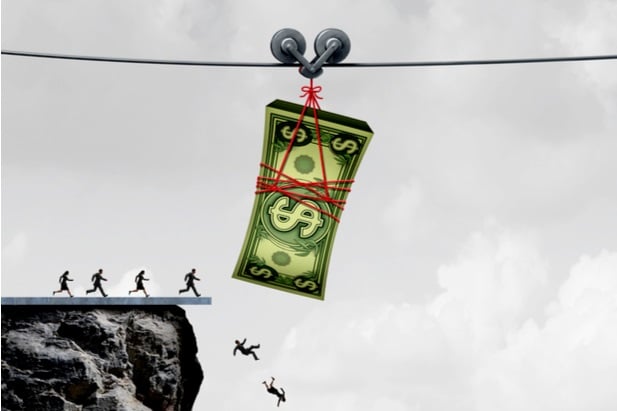 The spike in hardship withdrawals speaks to financial stress felt in the workplace, and its potential impact on employee health and productivity. (Photo: Shutterstock)
The spike in hardship withdrawals speaks to financial stress felt in the workplace, and its potential impact on employee health and productivity. (Photo: Shutterstock)
Hardship withdrawals from 401(k) plans have spiked in the short time since provisions in the Bipartisan Budget Act of 2018 gave plan participants more access to their tax-deferred savings, according to new data from Fidelity.
“We are seeing accelerations this year,” said Rashmi Venkatesh, senior vice president, Fidelity Investments.
The budget bill extended hardship withdrawals to not only individual deferrals, but also to sponsors’ non-elective contributions, matching contributions, and profit-sharing contributions, effective at the beginning of 2019.
It also removed the 6-month prohibition on contributions to retirement plans after the withdrawals, and it removed the previous requirement that a participant first exhaust loan options before taking a hardship withdrawal.
Since the beginning of the year, together, the percentage of participants taking loans and hardship withdrawals has not increased.
But more participants are going straight to hardship withdrawals before taking plan loans, which have to be paid back. Hardship withdrawals don’t, and are subject to a 10 percent penalty and income taxes.
Fidelity’s analysis of more than 33,000 retirement plans for which it is recordkeeper projects 4.4 percent of 23 million participants will take hardship withdrawals by the end of 2019.
That is twice the historical rate of 2.2 percent. Meantime, the percentage of savers taking plan loans is slightly down from 2018, at 9.2 percent.
The correlation between the Bipartisan Budget Act and the spike in hardship withdrawals is direct, says Meghan Murphy, vice president, Fidelity Investments.
“Going back to our data on hardship withdrawals, they have been extremely flat,” she said. “To all of a sudden see that number tick up starting in January of this year, likely hitting 4.4 percent by the end of the year—that is a huge change from what we have historically seen.”
Under the new rules, sponsors have discretion to retain guardrails within plan documents that require participants to first exhaust loan limits before taking hardship withdrawals.
For the time being, sponsors also have discretion to suspend contributions for 6 months after a hardship withdrawal. But beginning in January of 2020, the 6-month suspension option will be eliminated.
The good news is that only 3 percent of participants who are tapping hardship withdrawals have actively lowered their contribution rates.
The average withdrawal is about $2,900—not a huge amount, says Murphy.
Still, the implications on future savings rates can be real. But the new requirement to suspend the 6-month prohibition will insulate the impact. For instance, a 45- year old participant making $68,500 and deferring 7 percent of salary who takes two hardship withdrawals would lose $20,000 in savings at retirement if their contributions were temporarily suspended.
The emerging spike in hardship withdrawals has surprised sponsors, said Venkatesh and Murphy.
But perhaps more than the impact on future retirement coffers, the spike in hardship withdrawals speaks to financial stress felt in the workplace, and its potential impact on employee health and productivity.
Avoiding eviction or foreclosure and covering uninsured medical expenses are the top reasons for tapping savings, accounting for 73 percent of withdrawals.
“We know people are stressed when they are taking hardship withdrawals,” said Venkatesh. “The question is how can we make it easier to access money when they are under this stress. Are there steps sponsors can take in plan design to control the spike in withdrawals? And how can we encourage more financial wellness in the workplace that includes emergency savings that could prevent the withdrawals?”
Both sponsors and participants are taking meaningful actions under structured financial wellness programs, according to Fidelity’s data.
Since the firm rolled out its wellness program in 2016, 98 percent of Fidelity’s employer customers have adopted it.
As the program has evolved, more tangible solutions have been woven in, said Murphy. For example, since offering an emergency savings account option, 69 percent of participants are funding it when offered. “Whether they fund it to the fullest extent or not—some emergency savings is better than nothing,” she said.
When it’s possible, a loan is advised as a better option—participants don’t take the 10 percent penalty levied on a withdrawal, and can avoid taxes when it is paid back in time.
While a loan is being paid back, participants will see lower take-home pay, but ultimately what they pay back can be less than what they would have taken out in a hardship withdrawal.
“Once you qualify for a hardship withdrawal, you are in a difficult situation,” said Murphy. “We encourage everyone to use the available guidance.”
READ MORE:
Complete your profile to continue reading and get FREE access to BenefitsPRO, part of your ALM digital membership.
Your access to unlimited BenefitsPRO content isn’t changing.
Once you are an ALM digital member, you’ll receive:
- Breaking benefits news and analysis, on-site and via our newsletters and custom alerts
- Educational webcasts, white papers, and ebooks from industry thought leaders
- Critical converage of the property casualty insurance and financial advisory markets on our other ALM sites, PropertyCasualty360 and ThinkAdvisor
Already have an account? Sign In Now
© 2024 ALM Global, LLC, All Rights Reserved. Request academic re-use from www.copyright.com. All other uses, submit a request to [email protected]. For more information visit Asset & Logo Licensing.








